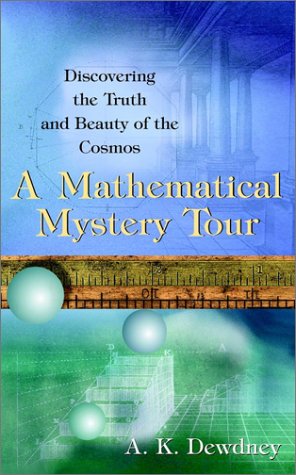
|
A Mathematical Mystery Tour
Discovering the Truth and Beauty of the Cosmos A. K. Dewdney John Wiley & Sons 2001 Paperback - 224 pages 5-1/2 x 8-1/2 ISBN: 0-47-140734-8 |
The timeless question: Is mathematics the very fabric of the cosmos, or does it exist only in the human mind?
Writing about his wonderment in this Mystery Tour, Dewdney searches through space and time for mathematical meaning in history. To go forth on this thought-provoking reading adventure, Dewdney takes readers on a theoretical world tour in which he uses a clutch of fictional tour guides at various ports of call to humanize what might be a rather intimidating subject.
Dewdney starts his fictional journey in:
- the Temple of Apollo at Miletus -- the ancient home of Pythagoras and other deep thinkers -- where he meets the first of his guides, an historian he calls Dr. Petros Pygonopolis. Then the journey continues to
- the southern desert of Jordan where Professor Jusuf al-Flayli of Cairo University offers insight into ancient Islamic astronomy; then to
- the winding canals of Venice where university professor Maria Canzoni reveals the mysteries of atomic theory; and to
- the medieval halls of Oxford, England, where mathematician Sir John Brainard explains the "engines of thought" in the form of Alan Turing's mind machines.
Dewdney has a sense of humor and his knowledge is thorough. This Ph.D. -- doing computer science at the University of Western Ontario -- has been author of several critically-acclaimed science and math books, including Yes, We Have No Neutrons, 200% of Nothing, The Armchair Universe, and The Planiverse: Computer Contact with a Two-Dimensional World.
Did humans make up mathematics, or did mathematics make up everything, including humans? Why do the cosmos - from the tiny world of atoms to the shape of the universe itself - seem governed by mathematical laws? Is our world is made of mathematics, as Pythagoras proposed? Or have the mathematicians made mathematics? Are the theorems and equations that describe the world around us discovered or created? Is mathematics the fabric of the cosmos or does it exist only in the human mind?
| SPACE TODAY ONLINE Covering Space From Earth to the Edge of the Universe | ||||||||
| Cover | Rockets | Satellites | Shuttles | Stations | Astronauts | Solar System | Deep Space | Global Links |
Copyright 2001 Space Today Online